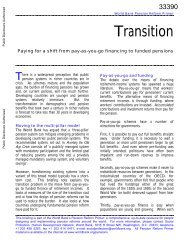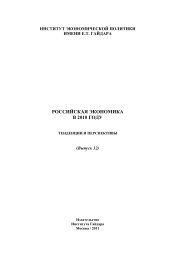Financial Sector Development in Africa: Opportunities ... - World Bank
Financial Sector Development in Africa: Opportunities ... - World Bank
Financial Sector Development in Africa: Opportunities ... - World Bank
Create successful ePaper yourself
Turn your PDF publications into a flip-book with our unique Google optimized e-Paper software.
92 Coates and Hofmeister<br />
Box 3.1<br />
Case Study: Buyer and Supplier F<strong>in</strong>ance <strong>in</strong> Ghanaian Cocoa<br />
Perhaps one of the best examples of short-term trade credit for agricultural<br />
producers is the cocoa value cha<strong>in</strong> <strong>in</strong> Ghana. Cocoa is a huge <strong>in</strong>dustry <strong>in</strong> Ghana,<br />
and the purchase of produce from producers is dom<strong>in</strong>ated by a market of private<br />
sector buy<strong>in</strong>g companies (licensed buy<strong>in</strong>g companies or LBCs) with licenses to<br />
sell to the state-owned market<strong>in</strong>g monopoly.<br />
These LBCs rout<strong>in</strong>ely provide significant amounts of short-term credit to<br />
producers for the purchase of the required <strong>in</strong>puts (for example, fertilizers and pesticides)<br />
before the grow<strong>in</strong>g season. In return, the cocoa growers agree to sell the resultant<br />
cocoa harvest to the LBCs at an agreed price. The capital and <strong>in</strong>terest are repaid<br />
to the LBC through the proceeds of the sale and the balance goes to the farmer.<br />
Similarly, credit can also be provided by the <strong>in</strong>put supplier. In another example<br />
from Ghana, one of the country’s largest suppliers of fertilizer and other agricultural<br />
<strong>in</strong>puts is provid<strong>in</strong>g supplies on credit to members of a major cocoa growers<br />
association, with repayment due follow<strong>in</strong>g the harvest.<br />
Source: Coates et al. 2011b.<br />
Such trade relationships exist all over <strong>Africa</strong>, wherever there are strong<br />
private sector players <strong>in</strong>volved <strong>in</strong> the value cha<strong>in</strong> with robust relationships<br />
with producers. The depth of trade credit, however, is <strong>in</strong>herently<br />
limited by the size of the balance sheets of these firms. Trade credit<br />
devours work<strong>in</strong>g capital, and most firms will reach their limits sooner<br />
or later.<br />
Build<strong>in</strong>g trade credit <strong>in</strong>to buyer and supplier f<strong>in</strong>ance. Buyer and supplier<br />
f<strong>in</strong>ance is simply the leverag<strong>in</strong>g of trade credit facilities with the <strong>in</strong>volvement<br />
of a bank. The mechanism allows the extension of significant<br />
amounts of credit by us<strong>in</strong>g the comb<strong>in</strong>ed balance sheets of both the firms<br />
and the bank.<br />
The advantages of this type of f<strong>in</strong>ance are clear to the bank:<br />
• The <strong>in</strong>termediary firm has close l<strong>in</strong>ks with producers at a grassroots<br />
level, and it is not essential for the bank to replicate the costs of <strong>in</strong>frastructure<br />
to reach this market.<br />
• The <strong>in</strong>termediary firm has already identified a pool of creditworthy<br />
borrowers who have developed a repayment record.







